When Did The University of Michigan become DTE’s Puppet?
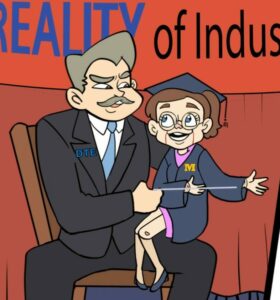 When researchers from public universities collaborate with the agenda of wind developers, not only do they compromise their own integrity — they compromise the integrity of the very institutions they represent. Yet ultimately, as research often leads to policy decisions, it is rural residents who are hit the hardest by a researcher’s bias. While we can document how research is funded, it is not as easy to document bias and disreputable relationships. Rural residents have the most to lose with our health, welfare and safety on the line.
When researchers from public universities collaborate with the agenda of wind developers, not only do they compromise their own integrity — they compromise the integrity of the very institutions they represent. Yet ultimately, as research often leads to policy decisions, it is rural residents who are hit the hardest by a researcher’s bias. While we can document how research is funded, it is not as easy to document bias and disreputable relationships. Rural residents have the most to lose with our health, welfare and safety on the line.
When Researchers Partner with Wind Bullies
A year ago, when we were trying to decipher the conflicting information on the wind industry, I stumbled across a newspaper article on wind energy in the “Thumb” of Michigan.
The article highlighted the findings of a University of Michigan doctoral candidate, named Sarah Mills, who had just released the findings of her survey study. Mills said that previously, there was either “pro-wind” people or “anti-wind” people telling you this and that. But now, she said, there was a third-party study to help townships decide whether or not to allow wind energy development — and she was that third-party.
The mission of the Ford School of Public Policy at the University of Michigan has stated that their mission is to “collaborate on evidence-based policy making to take on our communities’ and our world’s most pressing challenges.” Of course, all researchers have their own personal viewpoints. But what happens when a researcher’s relationships result in a complete deviation from the evidentiary platform of their research? How can rural communities equip ourselves against biased researchers who are attempting to influence the public and our local officials?
A Third-Party Promise
“Third-party” caught my attention — because hunting down objective information in regards to wind was tricky. The majority of information was indeed polarized: you were either pro-renewables or anti-renewables. Which then got extrapolated all the way into either being camp “Green Peace” or camp “Climate Denier” with little to no middle ground. As third-party research is often a factor in policy making, it can carry a lot of weight.
A google search later, I was reading her full survey results, entitled, “Farming the Wind: Preserving Agriculture through Wind Energy Development.” Mills wrote that her intent was to explore claims that wind turbines helped preserve farmland. She concluded that farmland preservation was rarely considered in the establishment of setbacks for industrial turbines. As such, the “amount of land rendered undevelopable” by turbines is “often substantial.”
After reading the abstract, I combed through the 260+ pages of Mills’ dissertation. Clearly there were financial benefits to lease-holders — not surprising, but there was additional insight here. Particularly telling were the quotes from people living with turbines, in the Thumb of our great state, Michigan.
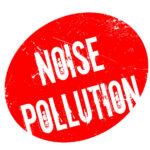
But there was something else too: there were several key issues that did not support DTE’s claims. Over half the people surveyed said they believe turbines decrease nearby property values — something DTE vehemently denies. And almost half feel that turbines create noise pollution. Another thing you will never hear DTE admit.
For almost every single “fact” that DTE presented, our efforts uncovered the untold REALITY of industrial wind. What Paul Harvey would have called the rest of the story.
May 2018
We did our best to uncover all the information that DTE doesn’t share. So when I gave the first public presentation for our township, in May of 2018, I referenced Mills’ survey results to counter several of DTE’s “facts.” DTE had chosen to only tell part of the story of wind energy. So we proceeded to untangle their spin — and we presented the REALITY of industrial wind.
Then the DTE executive, Matt Wagner, spoke during their portion of the agenda — and specifically referenced Sarah Mills. He said*, “I know Sarah Mills, really well. And it’s a great study, but there were a lot more positives. Sarah is an ethical researcher — if people tell her something, her work is going to include it.” (*As per my notes from that evening.) He summed up exactly what was refreshing about Mills’ survey data — it included the sentiments of folks living with industrial wind.
Of course there were positives documented in Mills’ survey results. Especially for the landowners who were leasing their land — no one doubted that. One big takeaway being that lease-holders were more confident of a succession plan for their farm. But that made no difference to me. We weren’t there to talk about Mills’ work in its entirety — we were there to provide a counterpoint to the limited amount of written specifics that DTE doles out to communities.
Our first public presentation was well received. We had been working hard to get the word out about the REALITY of industrial wind that DTE wasn’t sharing. And when DTE wouldn’t take questions in a group format, about half of those attending left in disgust. Our grassroots efforts were gaining ground and our little group that started as one community was expanding to include many of the townships around us.
The Road Show: Mills Comes to Town
The Sherwood Township supervisor, who was a leaseholder with DTE, said he had asked Sarah Mills to come and speak in our community in October of 2018.
And our community came out to hear what Dr. Mills had to say.
One of the first things she talked about was the impact on farming — which made sense, since her dissertation had been to study the impact of wind on farmland preservation.
But Mills started out, describing the amount of land that turbines take out of production, as only a “little” in her very talking point — which was exactly the opposite of how I remembered it!? Her dissertation had said the amount of land impacted was substantial!
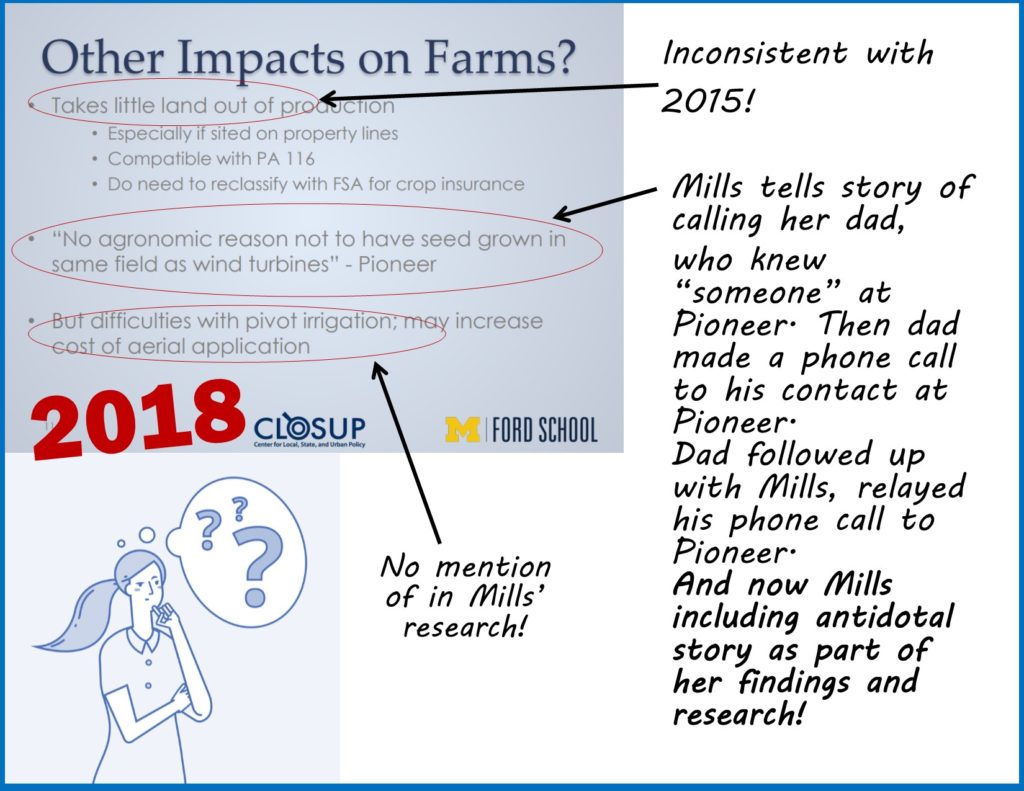
So, from the bleachers of the gym, listening to her talk, I pulled up the PDF of Mills’ dissertation.
And there it was. On the very first page of her dissertation.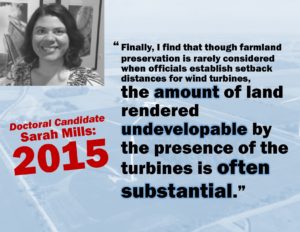
“…although farmland preservation is rarely considered when officials establish setback distances for wind turbines, the amount of land rendered undevelopable by the presence of turbines is often substantial.”
Why was the “often substantial” of 2015 apparently no longer the case? How did that become what Mills was now describing tonight as “little land taken out” of production?
While neither summary quantified the actual amount of land, the contradictory made zero sense.
By now, Mills was talking about Pioneer Seed company — which was curious because I hadn’t seen anything about seed contamination in any of her research surveys either. Yet this topic had been a discussion point at the previous Matteson Township Planning Commission meeting. It had been stated in Matteson that the Pioneer rep said they didn’t allow Pioneer seed to be planted in fields with turbines due to a higher threat of cross contamination. Now, while DTE’s subcontractors were at that public meeting — Sarah Mills was most certainly not.
So here was Mills, telling the story about how she called her dad, and how her dad had called a friend, who happened to work at Pioneer, and the friend at Pioneer had told Sarah’s father, oh no, they don’t not plant among turbines. And then Sarah’s dad called Sarah to tell her that, and now Sarah was telling us that — straight from Pioneer. Which somehow equated to a direct quote from Pioneer: there are “no agronomic reason not to have seed grown in same field as wind turbines.”
How does an anecdotal story, from a daughter calling her dad, who called a friend, get spit-shined into a direct quote from a major corporation? And then presented as part of research data? Do you think Pioneer would verify that statement as their official corporate position?
As Mills continued her talk, we sat and listened — clearly puzzled, by example after example of “information” that Mills was sharing with us, which diverged from the platform of her own research. Her presentation actually downplayed her own research. (We spoke briefly to Mills after her presentation that evening and followed up with a handful of emails as well.)
We left the meeting feeling disheartened, as Mills sounded nothing like a neutral third party. She sounded like DTE’s newest lobbyist. She had introduced information that wasn’t mentioned anywhere in her own research — I needed to go back and take another look.
What a Difference a Year Makes: Deviations Abound
When I went back and looked at Mills’ survey results, and compared them to my notes from the Sherwood meeting, it confirmed that many of her talking points were not part of her original platform. Upon closer examination, the Sherwood Township presentation I sat through, in October of 2018, was vastly different than the Pine Township presentation that Mills had given just one year earlier, in October of 2017.
Please review and compare the linked presentations. While only one year apart, they are filled with an alarmingly significant number of different talking points.
A side by side comparison revealed numerous, fundamental deviations from her research platforms. Mills had in fact minimized her own research and data in favor of DTE’s tactics and talking points.
It wasn’t just in the area of farming either. Mills had changed the building blocks of her message in the areas of: property values, noise, schools, job creation, health, and wildlife. Mills had deviated from the platform of her research on almost all of the key issues.
Unbelievable. A detailed tally revealed that Mills added over thirty “new” tidbits, or talking points, that were not the result of her own research. And she failed to reference or quantify many of those tidbits as well.
Here’s what we find when we take a closer look:
1. Deviations on Property Values Discussion
When Mills shared her findings on property values in her 2017 presentation to Pine Township, she stuck to the specific findings of her survey data. Which equated to over half of the landowners living in the Thumb reporting that they felt the presence of nearby turbines decrease property values. 54 percent of landowners reported they felt that way — which was exactly what her presentation included, without any additional information added.
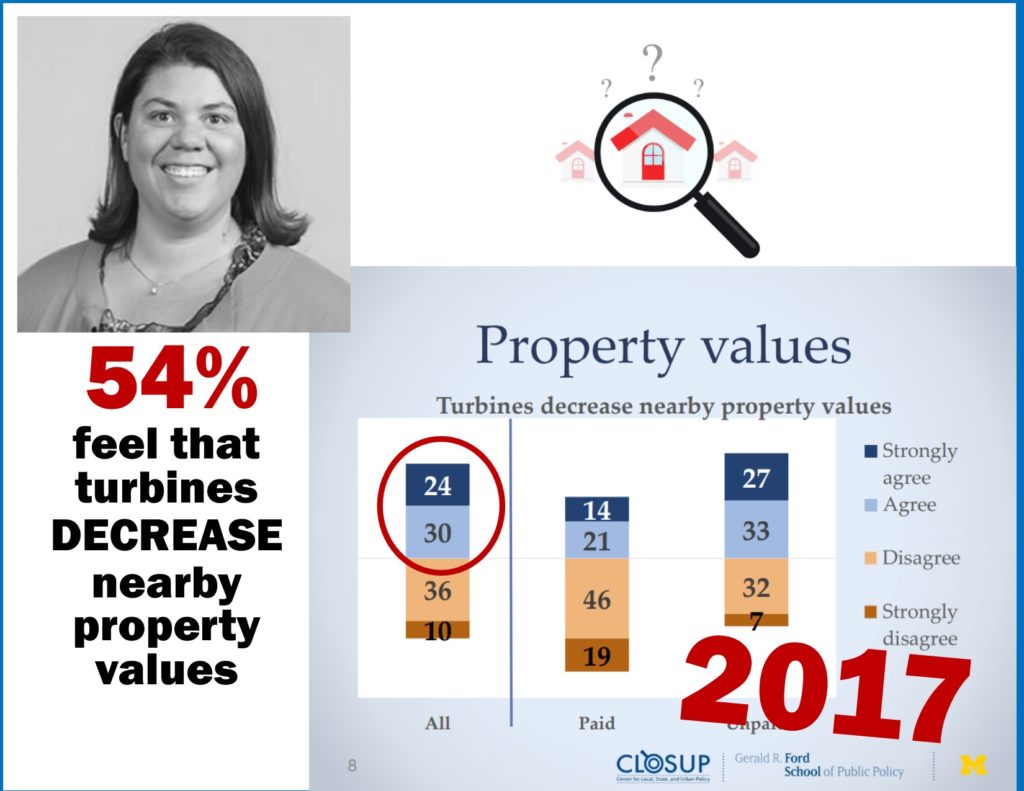
Yet that is NOT what Mills shared when she came to my community.
Mills started by saying that peer-reviewed studies showed no impacts from the nearby placement of turbines (which is misleading, at best, as to accurately assess the impact of turbines on residential property you need to study sales data, not assessed values used for taxation purposes). She referenced a “new study” without naming the research, which introduced the concept of self-sorting: that people of like minds live by turbines?
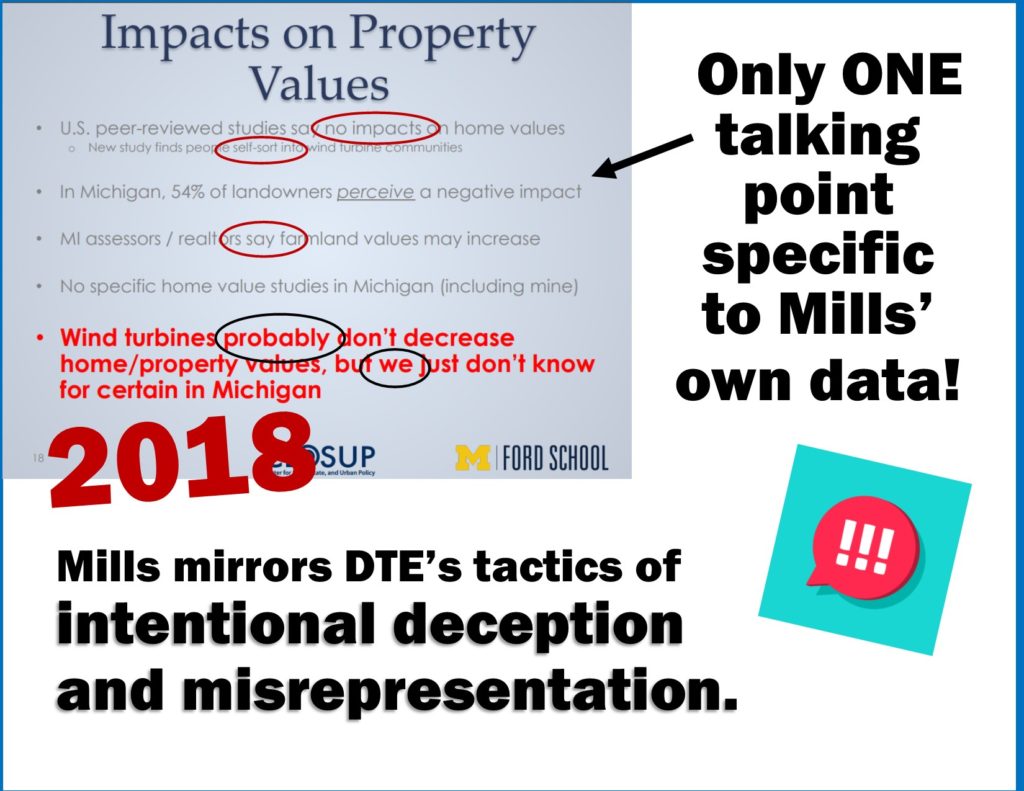
But then Mills downplayed her own research by describing it with added emphasis as a mere perception — 54 percent of landowners “perceive” a negative impact. What is Mills implying — that their perceptions were not relevant or misguided? That people living in the footprint of industrial wind aren’t astute enough to make that assessment? All rather odd insinuations for someone whose primary research tool is survey-specific data.
Mills then adds a few more unspecific, unquantified talking points: “realtors say,” “probably don’t decrease” and “don’t know for certain.”
This deviation is but one example of how Mills has chosen to contradict the very marching orders she shared at the beginning of her talks — as well as the marching orders of the Ford School of Public Policy — as she says she is providing a “data-based account of perceptions from Michigan wind communities.”
2. Deviations on Noise
Mills’ research found that 48 percent of all landowners surveyed believe that turbines create noise pollution. (Even 34 percent of paid landowners agreed that turbines created noise pollution.) Mills’ Pine Township talking points stuck to her survey findings.
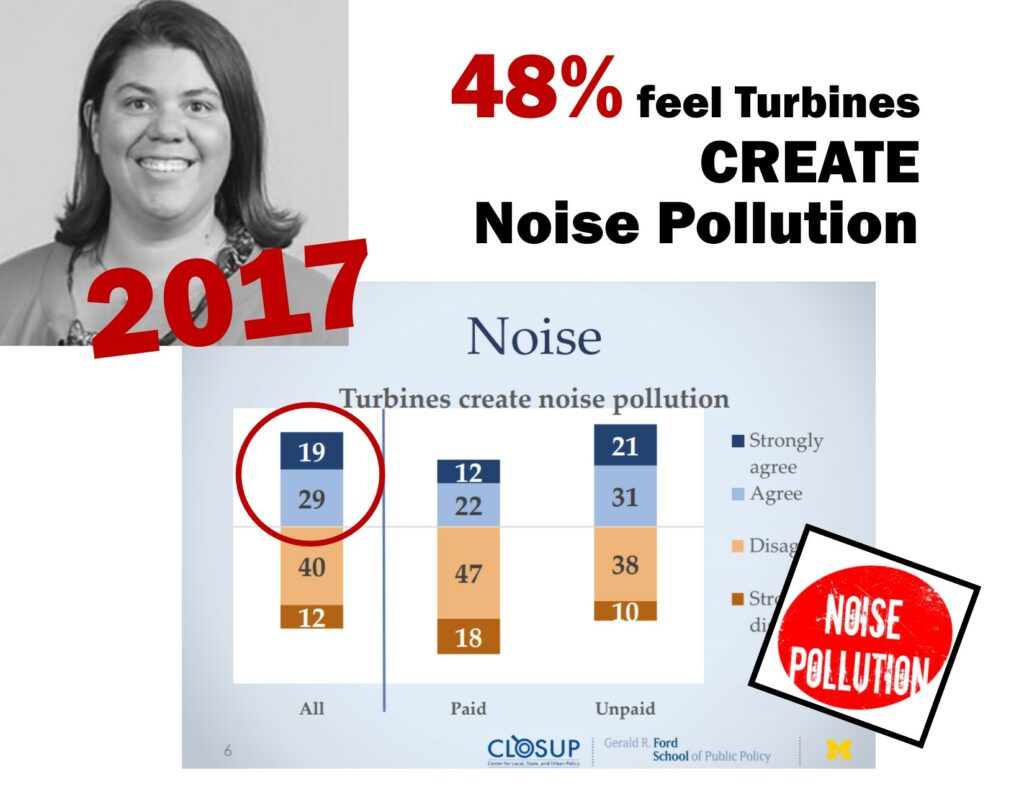
Yet when Mills presented at Sherwood Township, she shared a total of five talking points about the impacts of noise — and only 1 out of the 5 was based on her own research. She digressed into areas like hearing loss, sleep disturbances, World Health Organization recommendations — topics not covered in her own research. And not presented with any references or sources to support these additional talking points.
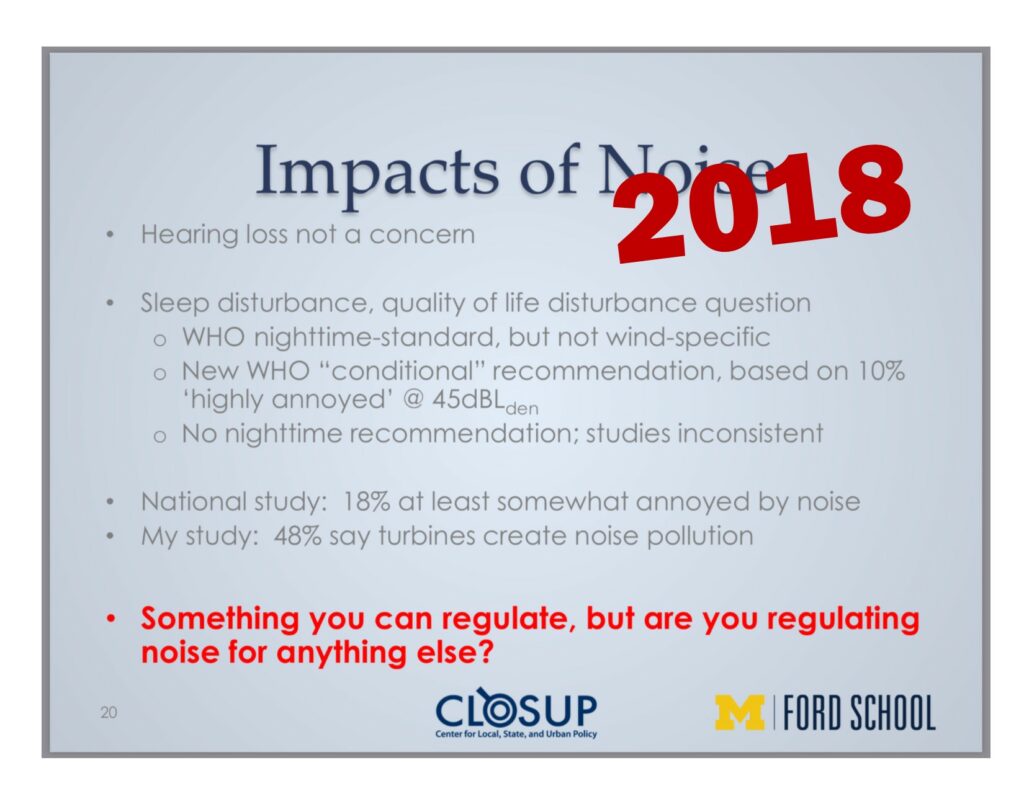
3. Softening the Blow for Lack of School Impact
When Mills presented to Pine Township, she shared her research which indicated 64 percent of landowners felt turbines neither improved or worsened their local schools — with 34 percent feeling they improved the local schools.
However, in 2017, Mills co-authored a study on the impact of wind energy on school finances. The study was summarized as such: “We conclude that the entrance of wind development has not affected the budgets of school districts in Michigan.”
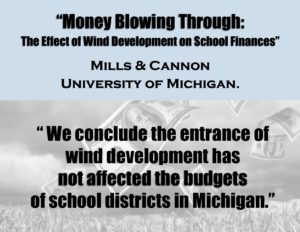
Yet by October of 2018, when Mills came to my county, her talking points to summarize the impact of wind had been massaged to conclude “the local school district may see little impact.”
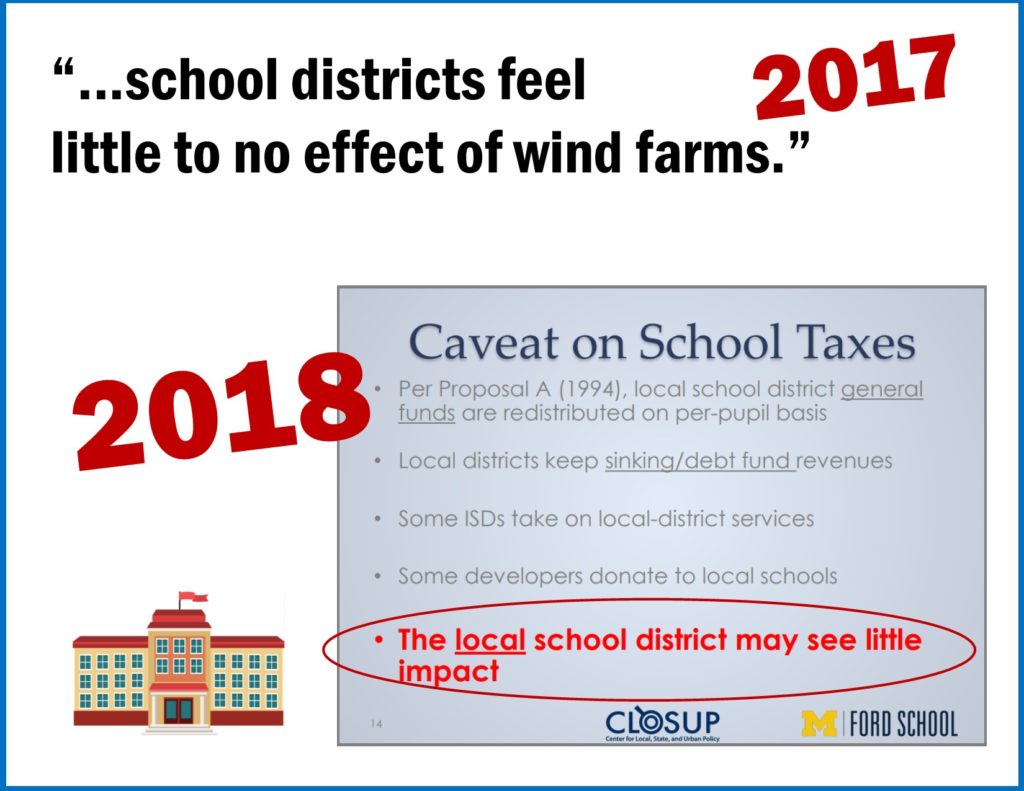
Why this wordsmithing of tweaking the sentiments that “school districts feel little to no effect of farms” into “may see little impact?” Of course, any summary is just that, a roll up on findings. But to have the 2017 finding say, “In this specific case, wind developers should be careful in promoting the benefits to local schools and not overstate the impact of their taxes” and then transform that into “may see little impact” in an attempt to soften the blow, appears to be another display of intentional bias implying a conflict of interest and commitment.
4. Deviations on Health Impacts
Mills’ presentation from Pine Township, in October of 2017, did not deviate from, or go above and beyond her own research findings (Pine Township) in regards to perceptions about health impacts.
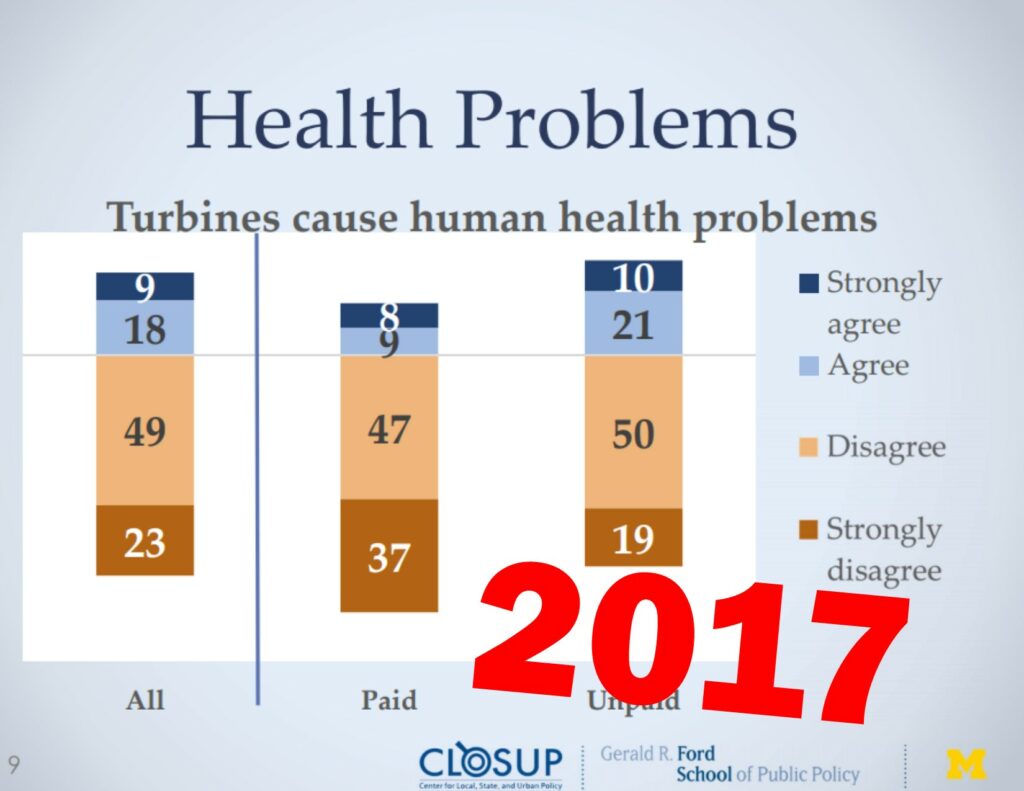
But, once again, when Mills spoke to in Sherwood Township, she downplayed her own research.
And then added in talking-points that mirror the same tactics and word-play that DTE uses, in regard to any impacts on human health. You see, DTE is notorious for saying, “Well, people don’t go to the emergency room because they live near a wind farm.” So when Mills parroted this tactic in her Sherwood Township stating “no direct health impacts” and mentioning the “power of suggestion” it rang eerily true to DTE’s trickery.
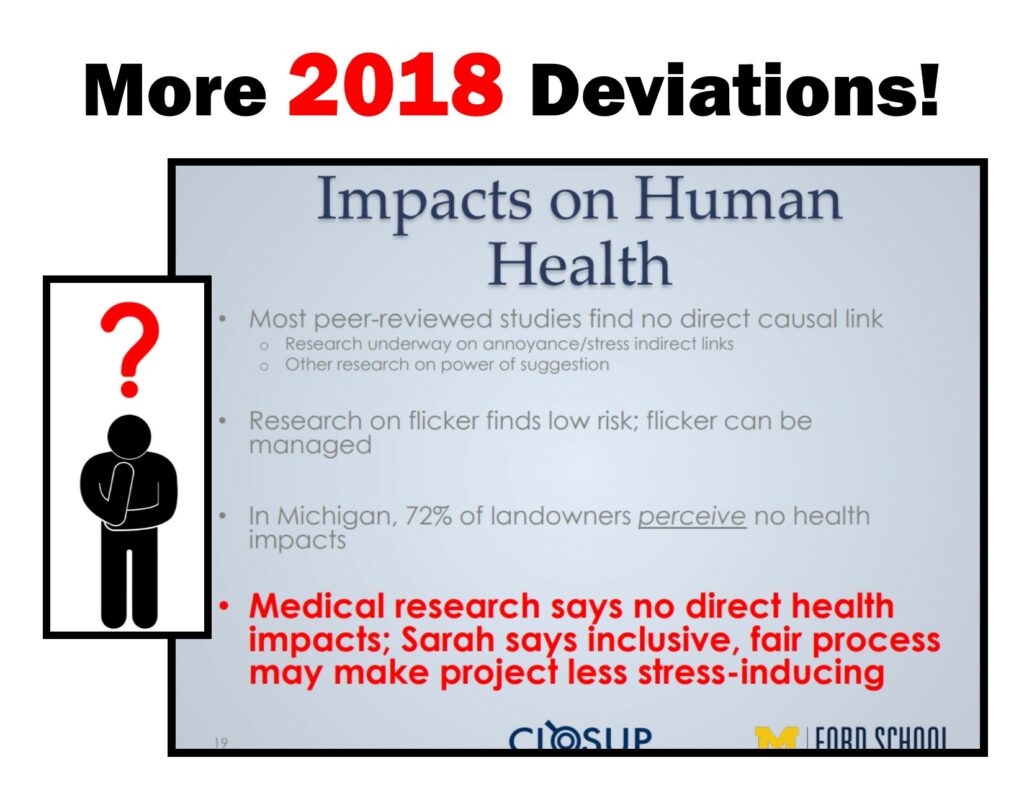
Numerous researchers have studied and documented health issues rooted in long-term exposure to noise. Researchers have documented the problematic consequences of improper siting that can cause indirect health issues for some people.
Just because people don’t go the ER for these particular types of indirect health impacts from improper siting, does not mean they don’t exist.
For one example, the state of Oregon’s Health Impact Assessment of Wind Energy describes “environmental noise in community settings (being) linked to sleep disturbance, annoyance, stress, and decreased cognitive performance. These effects, undesirable in their own right, can in turn adversely affect physical health. Chronic sleep disturbance and stress from environmental noise exposures may increase risks for cardiovascular disease, decreased immune function, endocrine disorders, mental illness, and other effects.”
5. Wildlife Discussion
In regards to wildlife impacts, during the Sherwood presentation, Mills didn’t even mention her own research. Instead, many of the tidbits she added mirrored the duck and dodge tactics of DTE — that is, failing to even acknowledge significant, relevant issues.
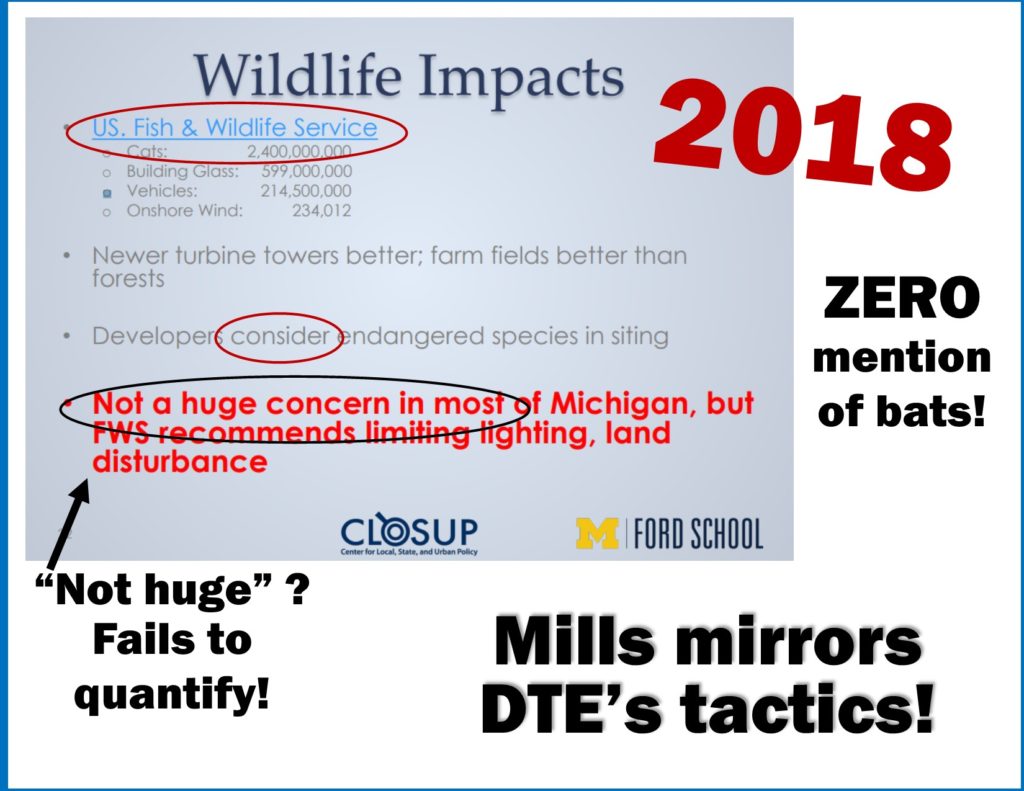
This is exactly the same shameful approach that DTE uses — ignoring the topic of bats all together.
Per the US Fish & Wildlife Service (USFWS), our bats are in trouble. One of the top U.S. bat experts, who heads up the NREL’s efforts to address bat fatalities from turbines, has said the bat population is bordering on a crisis. The value of bats in agriculture, in the continental U.S., is approximately $22.9 billion annually. Almost $23 BILLION annually and that bat population is “bordering on a crisis, as global increases of their mortalities was an unforeseen byproduct” of industrial turbines.
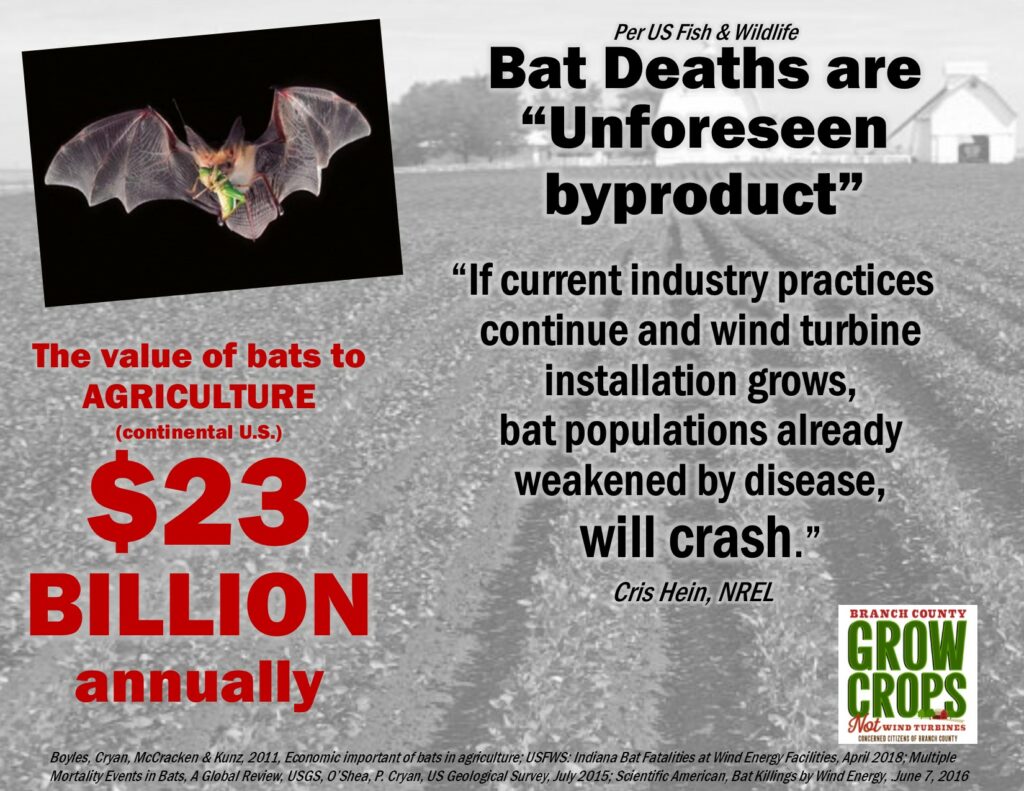
Yet Mills’ talking points sum up wildlife issues without one single mention of bats. ZERO mention of bats. Instead, Mills claims that wildlife impacts are “not a huge concern in most of Michigan (..)” concluding that the impact on wildlife is “comparatively minimal.” How reckless to be so intentionally misleading.

As Michigan’s field crops have the greatest economic impact in our state’s agricultural economy with $5.72 billion worth of impact annually, a diminished bat population cannot be deemed as trivial. How ridiculous for a researcher to quantify impacts as “not…huge.”
Clearly I am not an expert on bats, or even an agronomist, but Michigan field crops totalling $5.72 billion annually sounds “huge” to me. How arrogant to attempt to brush this particular issue under the rug.
Now What?
Mills has adopted the same underhanded half-truths that DTE tries pedaling. She has flagrantly stepped off the platform of her own data-based research findings and now mimics the sales pitch of the wind developer. How disreputable for a researcher to practice the same misleading tactics as the wind developer.
And Mills does this all while claiming to be a neutral third-party.
If Mills disclosed herself as pro-DTE, or a pro-wind energy advocate, I wouldn’t have much to say or reason to write this blog post. Because it isn’t Mills’ research data that is problematic. The problem is how Mills has used her research to gain access to policy makers in rural communities and then abandoned her platform in favor of DTE’s tactics and half-truths.
The issue is that Mills still claims to be a third-party and she introduces herself as a “neutral broker.”
Because at some point, Mills made the decision to step away from the results of her own research. Instead of reporting on her own findings, Mills is now sharing DTE’s talking points (and conspiring with DTE’s paid consultants*), to the point that Mills feels comfortable presenting herself as an expert in real estate appraisals, audiology, sleep medicine, agronomics, ornithology, psychology, and even a spokesperson for Pioneer Seed Company — to name a few.
Sarah Mills is not neutral and she has not maintained the integrity of the esteemed University that she represents.
You see, research integrity isn’t just avoiding plagiarism or falsifying data. The University of Michigan’s Standard Practice Guide outlines Conflicts of Interest and Conflicts of Commitments. It requires that faculty and staff not use their official positions or influence to further gain or advancement for themselves. As Mills stated in Sherwood Township, she is now considered the “expert” on wind energy in Michigan. She has presented information at over 24 rural communities across our state. Mills has advanced herself right into being a headliner for the DTE puppet show.
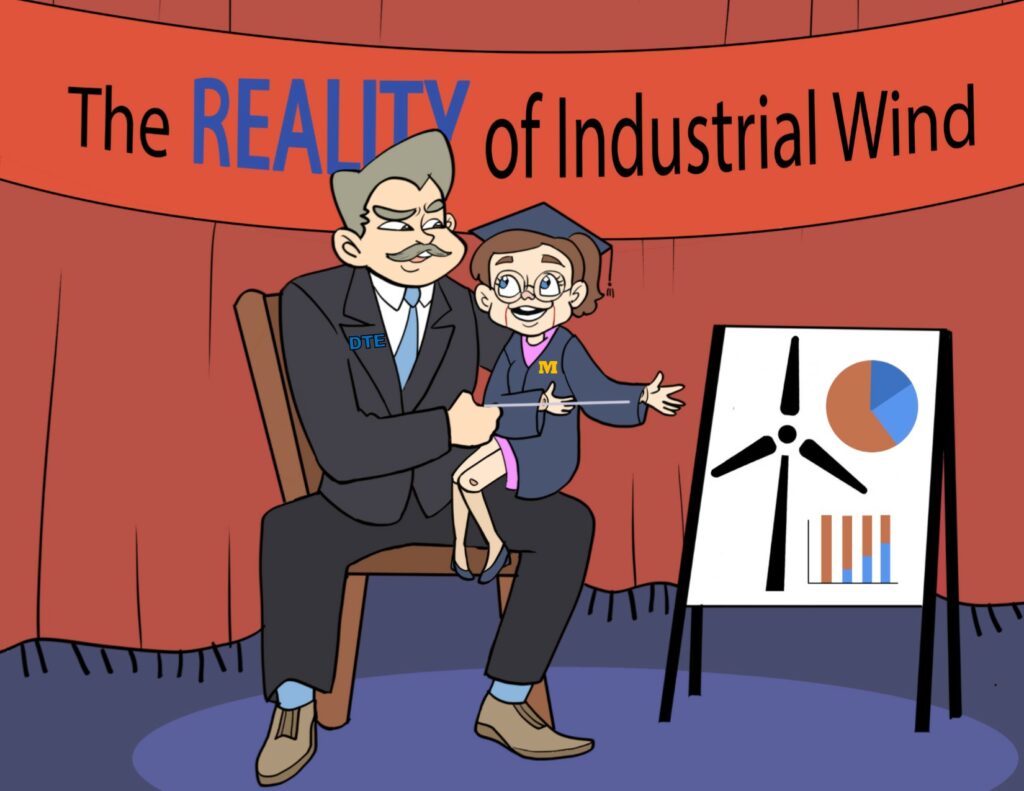
We will ask the University of Michigan to decide whether or not Mills’ activities have compromised her judgement, biased the nature or direction of her research, or influenced her decisions, behavior and interactions with rural communities like mine. The University specifies that a potential conflict of commitment exists when staff member’s external relationships or activities have the possibility of (in actuality or appearance) of interfering or competing with the University’s educational, research, or service missions.
At the very least, we will be insisting the University to reign Mills in and require that she go back to speaking about her own survey research, instead of parroting DTE’s sales tactics.
It is incredibly unjust for University researchers to deviate from the platform of their own work and align themselves with DTE without disclosing as much. When DTE comes into our communities, we can at least identify them as such — salesmen and subcontractors with a job to do. We don’t agree with DTE’s conduct or tactics — but at least we know their agenda. We can identify that ultimately, they are a for-profit company which answers to its shareholders.
But when a University of Michigan researcher is promoted as offering “non-biased information” to dozens and dozens of communities and policy making organizations, and then changes the very foundation of information shared — away from her own research — into the same sales pitch of the wind industry, it creates a reckless precedent. An undisclosed bias becomes a flagrant disregard for transparency — which clearly taints the standards of the University of Michigan and harms rural communities in the process.
*****
When researchers have relationships that interfere with their ability to present unbiasedly, they should be accountable for their actions.
When research is conducted at an esteemed university, it has the air of impartiality — something that for-profit players such as DTE use to their advantage.
While political bias is commonly accepted as the norm at the university level, there should be zero tolerance for conflict of interest and conflict of commitment based on relationships.
Our Coalition will be sharing our concerns with the appropriate parties at the University of Michigan. We are requesting the Sarah Mills return to the platform of her own research, instead of parroting DTE’s talking points.
We have requested copies of communication between Mills, our elected officials, consultants hired by DTE, as well as a handful of DTE employees and subcontractors. Regardless of what, if anything, is discovered as a result of that request, our communities here in Branch County — including our elected and appointed officials — have been mislead by Mills’ decision to deviate from her research platform. By aligning with DTE, Mills has diminished the integrity of both herself and the University she represents.
*****
On behalf of the Concerned Citizens of Branch County,
we welcome your feedback.
Please email our Coalition at: concernedcitizensofbranchco@gmail.com
Follow us on Facebook!
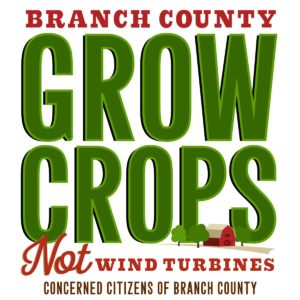
(* More to follow on Mills’ relationship with DTE’s paid consultant.)